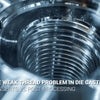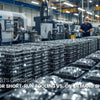5-Axis vs 3+2 Machining for Coffee Spouts: Which Process Delivers Better Surface Finish?

5-Axis vs 3+2 Machining for Coffee Spouts: Which Process Delivers Better Surface Finish?

Coffee spout manufacturing demands precision that directly impacts your espresso's taste and machine hygiene. While both 5-axis and 3+2 machining can create functional spouts, the surface finish quality varies significantly between these processes. Moreover, choosing the wrong machining method can lead to coffee oil buildup, flavor contamination, and increased maintenance costs.
Key Takeaway: 5-axis machining typically achieves smoother surfaces (Ra 0.4–1.6 μm) through continuous tool movement, while 3+2 machining may show repositioning marks (Ra 1.6–3.2 μm) requiring additional polishing. However, 3+2 offers better cost-effectiveness for high-volume production.
Understanding these machining differences helps manufacturers choose the right process for their coffee spout production needs. Furthermore, surface quality directly affects both coffee taste and equipment longevity. Let's examine how each method affects surface quality, cost, and production time.
Table of Contents
- Why Does Surface Texture Matter in Coffee Spouts?
- How Do 5-Axis and 3+2 Machining Work?
- Which Process Creates Better Surface Finish?
- What Are the Cost Differences Between These Methods?
- Conclusion
Why Does Surface Texture Matter in Coffee Spouts?
Surface roughness directly affects coffee quality and machine maintenance. Rough surfaces trap coffee oils, leading to rancid flavors and bacterial growth over time. Additionally, poor surface texture creates turbulence during espresso extraction, which can destroy the delicate crema layer that coffee enthusiasts value.
Critical Point: Surfaces rougher than Ra 3.2 μm trap coffee residue, while finishes below Ra 1.6 μm improve flow consistency and reduce cleaning requirements. Therefore, achieving proper coffee spout surface finish becomes crucial for maintaining beverage quality and equipment hygiene.

Coffee oils contain compounds that oxidize quickly when exposed to air. Therefore, smooth spout surfaces prevent these oils from accumulating in microscopic valleys. Additionally, smoother surfaces reduce turbulence during espresso extraction, which helps maintain consistent crema formation. Furthermore, food-safe regulations require specific surface finishes to meet FDA and EC1935 standards for equipment contacting beverages. Professional coffee equipment manufacturers understand that achieving proper surface roughness coffee spout specifications directly impacts both product quality and regulatory compliance.
How Do 5-Axis and 3+2 Machining Work?
Both machining methods offer multi-angle capabilities, but they achieve complex geometries through different approaches. Understanding these differences helps explain their surface finish variations. Moreover, each process has distinct advantages depending on the spout design complexity and production volume requirements.
Quick Comparison: 5-axis moves all five axes simultaneously for continuous tool paths, while 3+2 positions two rotary axes then machines with three linear axes. This fundamental difference in positional 5-axis vs simultaneous 5-axis operation creates distinct surface quality outcomes.
Simultaneous 5-axis machining maintains constant tool-to-work angles throughout the cut. This continuous movement eliminates repositioning marks that can create surface discontinuities. Moreover, the tool can maintain tangential contact with curved surfaces, reducing cutting forces and vibration. In contrast, 3+2 machining indexes to specific angles then locks the rotary axes. While this approach handles steep walls effectively, it creates potential alignment errors at repositioning points. However, 3+2 programming remains simpler and more cost-effective for many applications. Professional CNC machining services often help manufacturers choose between these approaches based on specific project requirements.
Which Process Creates Better Surface Finish?
Surface quality differences become apparent when comparing Ra measurements and visual appearance. The machining approach directly influences these finish characteristics. Additionally, tool path strategies significantly impact the final surface texture that customers will experience during daily use.
Finish Comparison: 5-axis typically achieves Ra 0.4–1.6 μm through continuous tool paths, while 3+2 produces Ra 1.6–3.2 μm with potential seam lines at repositioning points. This comparison highlights why 5-axis vs 3+2 machining selection depends heavily on surface quality requirements.
Tool path continuity gives 5-axis machining a significant advantage for surface smoothness. Since the tool never lifts from the workpiece during complex angle changes, it eliminates the micro-mismatches that occur during 3+2 repositioning. Additionally, 5-axis can maintain constant chip load across varying surface angles, reducing cutting force variations that cause surface irregularities. Nevertheless, 3+2 machining can achieve excellent results on simpler geometries where repositioning occurs infrequently. The step-over effect in 5-axis also reduces visible seam lines that sometimes appear in 3+2 parts. Achieving proper surface finish often requires understanding these fundamental machining differences.
What Are the Cost Differences Between These Methods?
Machine investment and production efficiency vary significantly between these machining approaches. Cost considerations extend beyond initial equipment purchase to include setup time and labor requirements. Furthermore, multi-angle coffee spout manufacturing complexity directly impacts the cost-benefit analysis between these two processes.
Investment Range: 5-axis machines cost $80K-$500K compared to 3+2 systems at $25K-$50K, but 5-axis reduces setup time by eliminating fixturing changes for multi-angle spouts. Additionally, labor costs decrease when operators don't need to reposition parts multiple times during machining.
Initial machine costs favor 3+2 systems, making them attractive for budget-conscious operations. However, 5-axis machines can cut spout production time by 30-50% through single-setup machining. For example, a five-angle spout requires only one setup with 5-axis versus three or more setups with 3+2. Therefore, 5-axis becomes cost-effective for complex, low-volume parts despite higher machine costs. Conversely, 3+2 excels in high-volume production of simpler spout designs where setup time represents a smaller percentage of total cycle time. When working with various CNC metals and plastics, manufacturers must consider material-specific machining requirements that can influence the final cost analysis.
Conclusion
Choosing between 5-axis and 3+2 machining for coffee spouts depends on your specific production requirements. 5-axis delivers superior surface finish and reduces production time for complex geometries, making it ideal for specialty espresso machine manufacturers. Meanwhile, 3+2 offers excellent cost-effectiveness for high-volume commercial spout production. Both processes can achieve food-safe surface texture CNC standards when combined with appropriate post-processing techniques like electropolishing.
Consider 5-axis machining when producing low-volume, high-precision spouts with complex curves or when surface quality takes priority over cost. Choose 3+2 machining for high-volume production runs where simple geometries allow efficient repositioning strategies. Ultimately, both processes can deliver quality coffee spouts when properly implemented with suitable post-processing and quality control measures.
External Links Recommendation:
[5-axis vs 3+2 machining][^1]
[coffee spout surface finish][^2]
[multi-angle coffee spout manufacturing][^3]
[surface roughness coffee spout][^4]
[positional 5-axis vs simultaneous 5-axis][^5]
---
[^1]: Understanding the differences can help you choose the right machining method for your project, enhancing efficiency and precision.
[^2]: Exploring techniques for surface finish can improve product quality and customer satisfaction in coffee spout manufacturing.
[^3]: Learning about best practices can optimize your manufacturing process, leading to better designs and reduced costs.
[^4]: Understanding surface roughness can enhance the quality and performance of coffee spouts, making your brewing experience better.
[^5]: Exploring this comparison can help you choose the right machining method for your projects, optimizing efficiency and precision.





